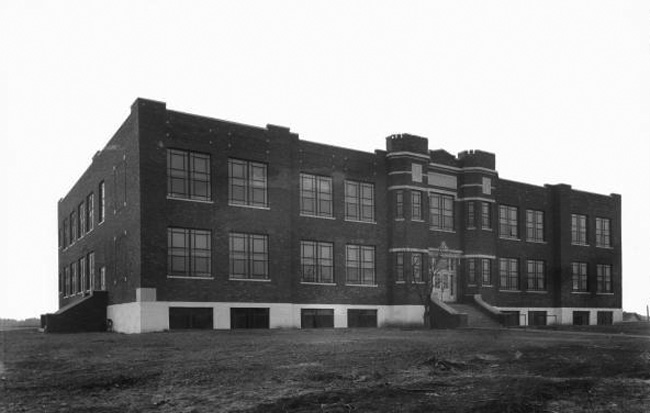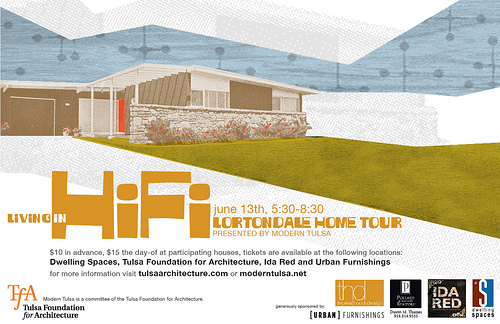Tulsa History: June 2009 Archives
A browser crash took out a bunch of edits to a post about my recent trip to southern California, and I'm in no mood to recreate all that now.
So crack open a Mulo and visit Irritated Tulsan and his collection of vintage ads from summers past, including one for the Kip's Big Boy at 11th and Trenton. He's got some pretty neon photos, too, and he wants your favorite memories of Bell's Amusement Park.
Modern Tulsa has a photographic recap of the "Living in Hi-Fi Tour" of Lortondale's mid-century modern homes.
Holly Wall has a guest post up at Tasha Does Tulsa reporting on Thirsty Thursday at Drillers Stadium.
A fascinating new blog, Tulsa Gal, focuses on Tulsa history. Nancy is a researcher and volunteer for the Tulsa Historical Society.
Finally, make your blood boil with the Infrastructurist's then-and-now photos of beautiful train stations that met the wrecking ball.
Notes about demolition and neglect, here and elsewhere:
From the Beryl Ford Collection/Rotary Club of Tulsa, Tulsa City-County Library and Tulsa Historical Society.
Red Fork's oldest remaining high school building is to be demolished. The 1925 building served for most of its history as Clinton Middle School, but when first built it was the high school for the Red Fork district, which was previously located on the Park Elementary campus, which dates back to 1908. (The Park high school was built in 1918, according to the Sanborn map, but has been gone for decades.) Clinton continued as a high school until 1938, when Daniel Webster High School opened. This story tells about the time capsule discovered in its cornerstone:
When officials took down the cornerstone, they found a copper box not much bigger than a car stereo in a gap in the brick wall.In it, they found a small U.S. flag with 48 stars, several yellowed copies of The Tulsa Tribune newspaper, and lists of members of the Order of the Eastern Star, Red Fork Masons, Red Fork school board members and faculty and staff members at Clinton, which was a high school in 1925.
The Tulsa Public Schools website has a slide show and high resolution images of some of the objects in the Clinton Middle School cornerstone.
The first time I found my way onto W. 41st Street many years ago, I was impressed and amazed by the civic buildings along this half-mile stretch between Union Ave. and Southwest Blvd:Trinity Baptist Church, Pleasant Porter School (originally Clinton Public Grade School), sited in a shady grove of tall trees, Clinton Middle School, and the Clinton Memorial First Baptist Church of Red Fork -- each had a certain dignity that marked Red Fork not as a suburb, but as a town in its own right. The old Baptist Church was demolished to make way for the new Clinton Middle School; now the old school is being torn down after 84 years of service.
(Here's some more historical information on the Clinton family and the school that stood on their old homestead.)
Four miles north-northeast, someone has taken photos of the interior of the Tulsa Club building, on the northwest corner of 5th and Cincinnati. The art deco building has been left to rot, unsecured, by its current owner, and it has become the target of graffiti vandals who seem to know that no one cares. I've been in the building twice: Once for the school prom ("Dutchman Weekend") my sophomore year in high school, and once just after the Tulsa Club shut down for good and the fixtures were auctioned off. There are hints of what once was, but the interior is pretty well trashed.
On to Detroit, where the last vestiges of old Tiger Stadium, aka Briggs Stadium, are being demolished for no good reason. The infield stands still stood, and preservationists had been working successfully to raise funds to preserve them, maintain the diamond as a community ball field, and use the stadium structure as a museum to house broadcaster Ernie Harwell's collection of memorabilia. Despite the progress of preservationists in raising funds, the Detroit City Council decided to turn even more of their once-bustling city into flat nothingness.
Neil de Mause explains what made Tiger Stadium special and worth saving:
Tiger Stadium is now the last surviving example of an old-style upper deck overhang. Yankee Stadium will be gone shortly; Fenway Park doesn't have an upper deck to speak of; and Wrigley Field, for all its charms, has a top deck set way back from the action. That leaves the sliver of stands still standing in Detroit as the only place in the world where baseball fans will be able to experience what was once commonplace: cheap seats that, thanks the miracle of cantilevering and the willingness to make some field-level patrons sit in the shade, are closer to the field of play than all but the priciest field-level seats at modern stadia -- stunningly close at Tiger, where Tom Boswell famously wrote that sitting in the upper deck behind home plate and watching Jack Morris pitch enabled him to truly learn the importance of changing speeds.
I saw a game there once. In 1988, my last full summer of bachelorhood, my friend Rick Koontz and I went on a week-long "Rust Belt Tour" that took us to Wrigley Field, Comiskey Park (the original one), Tiger Stadium, Cleveland Municipal Stadium ("the mistake by the lake"), and Riverfront Stadium. 21 years later, only Wrigley still stands. We had great seats to watch the Tigers play the Yankees, a game the Tigers won, 7-6 in the bottom of the ninth, a six-run inning that concluded with an Allan Trammell grand slam home run. It was the most exciting game of the trip, and a great place to watch a game. (It was also the night the Pistons lost to the Lakers in Game 7 of the NBA finals. We were relieved, given Detroit's reputation for violent celebrations.)
National Trust for Historic Preservation president Richard Moe writes of Tiger Stadium:
Demolishing the stadium is a mistake. Even in its diminished, partly demolished state, the stadium served as a defining feature of the historic Corktown neighborhood-a reminder of better days, but also a cornerstone for future revitalization of the community. Redevelopment of this iconic historic place for, among other things, youth baseball leagues, could transform it back into the thriving center of community activity that it once was. Now, city leaders have chosen a course that will in all likelihood lead to yet another empty lot in Detroit-the last thing the city needs.
More from the National Trust for Historic Preservation on Tiger Stadium's demolition:
Despite a protest at Tiger Stadium last week, Detroit contractors began razing the 1923 structure the following day. Late Friday afternoon, a judge issued a temporary restraining order, which should have halted all destruction, but crews continued demolition until the end of the day.On Monday Wayne County Circuit Judge Prentis Edwards lifted the restraining order and rejected the conservancy's request for the injunction.
"[Demolition crews] were out there an hour after the decision. They didn't waste any time," says Michael Kirk, vice president of the Old Tiger Stadium Conservancy, which requested a permanent injunction to halt the demolition. "We don't understand it. There's no other development deal pending for the site, so the need for speed doesn't make any sense."
City attorneys argued that the conservancy could not raise enough for the $27 million construction project to retain Navin Field, the oldest part of the existing stadium complex.
Plans to demolish the remaining section of the old stadium were set back in motion after a 7-1 vote on Tuesday, June 2, by the board of Detroit's Economic Development Corporation. Waymon Guillebreaux, executive vice president, said in a statement last week that the Old Tiger Stadium Conservancy "is still far short of its targets" agreed upon in a memorandum of understanding with the city that was signed last fall and claimed the conservancy did not have "secure commitments for funding the project."
The board acted despite $3.8 million earmarked by Sen. Carl Levin (D-Mich.) for the Old Tiger Stadium Conservancy's plan; an identified $19 million from new market, "brownfield," and state and federal historic tax credits (some of which were already applied for and approved); and $500,000 in grants, loans and private donations.
Lowell Boileau, a painter, created a website in the late '90s called The Fabulous Ruins of Detroit, a site that contains hundreds of images of abandoned and now-demolished buildings, including abandoned suburban buildings that took the place of previously abandoned urban buildings.
Zimbabwe, El Tajin, Athens, Rome: Now, as for centuries, tourists behold those ruins with awe and wonder. Yet today, a vast and history laden ruin site passes unnoticed, even despised, into oblivion.Come, travel with me, as I guide you on a tour through the fabulous and vanishing ruins of my beloved Detroit.
It's a tour worth taking -- well-organized with an "express" path that hits the highlights, and "detours" that allow deeper exploration.
Sadly, at a time when mainstream public support for historic preservation is growing, the National Trust for Historic Preservation has decided to squander its hard-won credibility by turning its blog over to the promotion of "gay pride" during the month of June, in a series of posts that have nothing to do with preserving and protecting historic buildings. (One exception: There is a post about preservation in West Hollywood; the "gay" connection is that it was written by a preservationist drag queen.) The latest example is this essay on "gayborhoods" entitled "Pardon Me Sir, But Can I Queer Your Space." This is a classic example of a venerable organization being hijacked to serve someone's personal agenda rather than the cause for which it was founded.
There are a couple of tours happening in and around Tulsa this weekend that may tickle your fancy:
An all-day bus tour of historic all-black towns will take place this Saturday, from 7 am to 5 pm. Freed slaves from the Muscogee (Creek) Nation founded a number of towns south and east of Tulsa around the turn of the 20th century. Other towns were established in the newly opened Oklahoma Territory at the end of the 19th century as part of a black statehood movement.
The tour is $30. For information and to make reservations call 918-596-7280. (Found via TheMidtowner.)
This New York Times story is a good introduction to Oklahoma's all-black towns. Alison Zarrow has made her photoessay on Oklahoma's black towns, Wish You Were Here, available online.
This Saturday evening, 5:30 to 8:30 pm, the Modern Tulsa committee of the Tulsa Foundation for Architecture is hosting a tour of homes in the mid-century modern neighborhood of Lortondale, east of Yale Ave. between 26th and 28th Streets.
Designed and built in 1954 by Tulsa duo Donald Honn (architect) and Howard Grubb (builder), the Lortondale Neighborhood was the recipient of a multitude of national design awards. The neighborhood was featured in an array of magazines including House and Home and Better Homes and Gardens.In recent years Lortondale has experienced something of a rebirth. A new generation of homeowners, interested in modern design, are snapping up the houses just as fast as they come on the market. After decades of neglect, many of the houses in the neighborhood are being restored to their former modern glory. Most importantly, the Lortondale Community is experiencing the same restoration.
This year's tour seeks to convey the energy that is the Lortondale Neighborhood today. Featured are 6 houses in various stages of completion. From the beginning stages of a restoration to a virtually complete example of HiFi-modern bliss, this tour of Lortondale will show you what all the buzz is about.
Tickets are $10 in advance, $15 the day of the tour, and available at Dwelling Spaces, Urban Furnishings, Ida Red Boutique, and the Tulsa Foundation for Architecture office. All the details are available at the Modern Tulsa website.
The tour is self-paced. You can start at any home and purchase a ticket at the first house you visit:
- 4912 E. 26th Terrace
- 5331 E. 26th Pl.
- 5342 E. 26th Pl.
- 4953 E. 27th St.
- 4958 E. 27th St.
- 5312 E. 27th St.
There's an ongoing online tour you can follow vicariously. A family is visiting all 77 of Oklahoma's counties, taking photos, and recounting their travels. You can follow their progress on the 77 Counties blog. (The latest entries will also be linked on the BatesLine Oklahoma headlines page.)
 I'm in the throes of a major effort at work and only have time to throw you a few links to good reading elsewhere:
I'm in the throes of a major effort at work and only have time to throw you a few links to good reading elsewhere:
For your viewing pleasure, Tulsa TV Memories links to the Life archive and photos from February 1952 of KOTV general manager Helen Alvarez. Besides photos of the lovely Mrs. Alvarez, the archive shows the Channel 6 news, weather, and sports sets of the day, plus photos from the Sun Refinery and of a powwow. (Does this qualify as a Rule 5 post?)
Irritated Tulsan discovers that the Boulder Ave. bridge is safe enough -- for the crane that's demolishing it.
Steve Roemerman has posted a new podcast, reacting to Councilor G. T. Bynum's comments during last week's ballpark assessment vote.
Chris Medlock has a new podcast up, reacting to comments about city election "reform" made by former Mayor Susan Savage. And he talks to State Sen. Randy Brogdon about the legislative session and the gubernatorial campaign.

